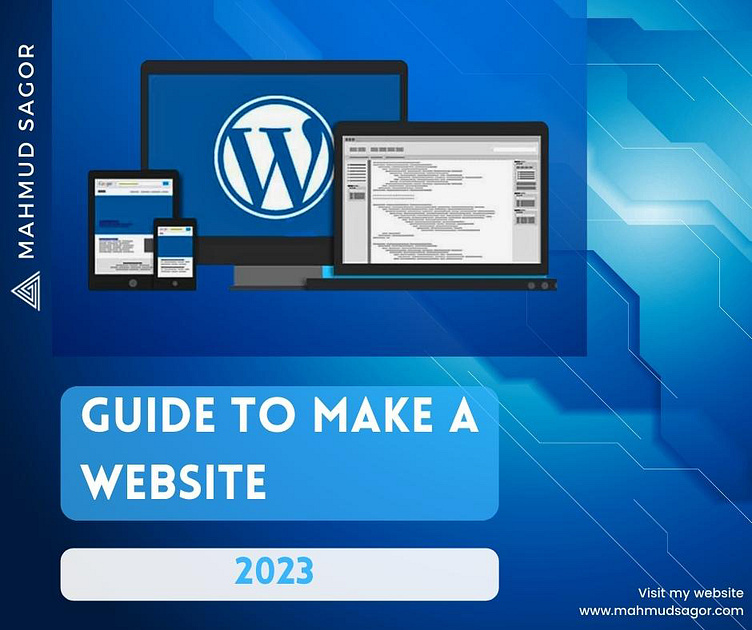Ultimate Guide: How to Make a Website in 2023
👉 Step 1. Setup:
One of the most common mistakes that newcomers make is choosing the wrong website platform. Thankfully, you’re here so you won’t be making that mistake.
For most users, a self-hosted WordPress.org site is the perfect solution. It comes with thousands of designs and add-ons that allow you to create any kind of website you can imagine. For more on this topic, please see our guide on why you should use WordPress.
WordPress is free for anyone to download and use to create any kind of website without any restrictions.
👉 Step 2. WordPress Installation:
There are several ways to install WordPress, depending on your needs and technical expertise. Here are some common methods: Choose a host that comes with WordPress pre-installed: Many web hosting providers offer WordPress hosting plans that come with WordPress pre-installed. This is the easiest and quickest way to get started with WordPress.Install WordPress via cPanel and auto-installers: Many web hosting providers offer cPanel, which includes auto-installers like Softaculous or Fantastico that can automatically install WordPress for you. Install WordPress manually via FTP: If you’re comfortable with FTP, you can manually upload the WordPress files to your web server and install WordPress.Install WordPress on your own computer: You can also install WordPress locally on your own computer for testing and development purposes. This requires setting up a local server environment using software like WAMP, MAMP, or XAMPP.
👉 Step 3. Select Your Name:
The visual appearance of your WordPress site is controlled by a WordPress theme.WordPress themes are professionally designed templates that you can install on your website to change its appearance. By default, each WordPress site comes with a basic theme. This isn’t really appealing for most users. But don’t worry, there are thousands of free and paid WordPress themes that you can install on your site.
👉 Step 4. Add Content to Your Site:
WordPress comes with two default content types, posts and pages. Posts are part of the blogging functionality and appear in reverse chronological order (newer items are displayed first).On the other hand, pages are meant to be static “one-off” type content such as your About page, Contact page, Privacy Policy, Custom Landing Page, etc. By default, WordPress shows your blog posts on the front page of your website. You can change that, and make WordPress show any static page as the homepage of your website (we’ll show you how to do that later in this guide). You can create a separate page for your blog or news section to show your recent posts. Alternatively, you can create a website without any blog section at all. Having said that, let’s add some content to your website. You’ll start by adding several pages to your WordPress site. Don’t worry if you don’t have enough content for these pages at the moment. You can always edit and update them.
👉 Step 5. Customizing and Tweaking Your Website:
Now that you have created some content for your website, you’ll be able to customize and put it all in a nice presentable shape for your users. Let’s start by setting up a static front page (also known as a homepage). Don’t forget to click on the ‘Save Changes’ button at the bottom of the page to store your changes.WordPress will now use the page named ‘Home’ as your site’s front page and ‘Blog’ page to display your blog posts. Change Site Title and TaglineDuring the installation, you get to choose your site’s title. WordPress automatically adds a tagline to your site title that says ‘Just another WordPress site’. You can change both your site’s title and tagline at any time by visiting Settings» General page. Set up Comment Settings WordPress comes with a built-in comment system allowing your users to leave comments on your posts. This is great for WordPress user engagement, but it’s targeted by spammers as well.To deal with this, you’ll need to enable comment moderation on your website. Create Navigation Menus. Navigation menus allow your users to browse different pages or sections on your website. WordPress comes with a powerful navigation menu system, and your WordPress theme utilizes this system to display menus. Setting up a Static Front Page: You need to visit the Settings» Reading page in your WordPress admin dashboard. Under the ‘Front page displays’ option click on the static front page and select ‘Pages’ you created earlier for your home and blog pages.
👉 Step 6. Installing Plugins:
WordPress Plugins are like apps for your WordPress site. They allow you to add features and customizations to your WordPress site such as contact forms, photo galleries, etc. You can install plugins from your WordPress dashboard by clicking on the Plugins page. There are currently more than free plugins available for WordPress. There are also paid plugins offered by third-party websites and developers. With these numerous plugins, how do you find which plugins to install? We got you covered there as well, Seed our guide on how to choose the best WordPress plugin.
👉 Step 7. Learning WordPress:
WordPress is easy to use, but it’s also an extremely powerful content management system. From time to time, you may find yourself looking for some quick WordPress help. The good news is that there is plenty of free WordPress help available. See our guide on how to properly ask for WordPress support and get it.
🌐 To learn more about me, explore my services, portfolio, contact information, hiring me or any assistance: https://www.mahmudsagor.com
🗓️ Schedule a complimentary consultation: https://calendly.com/mahmudsagor/30min-freelance-consultancy
🔍 Explore my blogs for regular insights on Web Development, Design, Digital Marketing, e-commerce, Graphic Design, and Technology:
1️⃣ Website Blog: https://www.mahmudsagor.com/blog
2️⃣ WordPress Blog: https://whatmahmudsagorwrites.blogspot.com
3️⃣ Medium: https://mahmudsagor.medium.com
4️⃣ Tumblr: https://mahmudsagor1207.tumblr.com
🔗 BrandYourself: http://mahmudsagor.brandyourself.com
